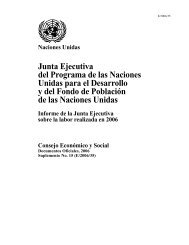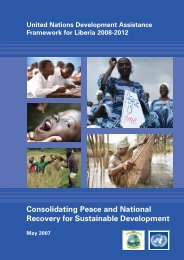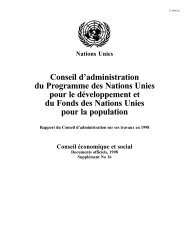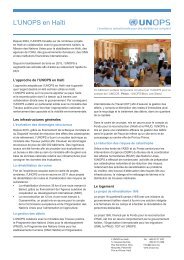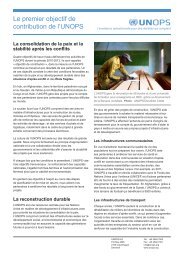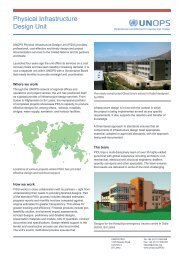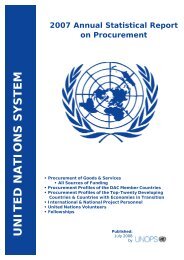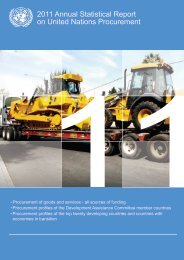India UNDAF 2008-2012 - UNOPS
India UNDAF 2008-2012 - UNOPS
India UNDAF 2008-2012 - UNOPS
Create successful ePaper yourself
Turn your PDF publications into a flip-book with our unique Google optimized e-Paper software.
<strong>India</strong> <strong>UNDAF</strong> <strong>2008</strong>-<strong>2012</strong><br />
Section II: Results<br />
<strong>UNDAF</strong> Results Summary<br />
"Promoting social, economic and political inclusion of the most disadvantaged, especially<br />
women and girls" is the mission statement of the <strong>India</strong> <strong>UNDAF</strong> <strong>2008</strong>-<strong>2012</strong>, and<br />
the touch stone to measure the success of the outcomes outlined in the Framework.<br />
Four <strong>UNDAF</strong> outcomes have been agreed with a view to achieving the goal outlined in<br />
the mission statement. The first <strong>UNDAF</strong> outcome is to support the large centrally<br />
sponsored schemes, especially on aspects of implementation. Recognising that the<br />
district level is particularly important for effective implementation, the second <strong>UNDAF</strong><br />
outcome focuses on contributing to strengthening governance systems-elected and<br />
administrative--at the district level. The third <strong>UNDAF</strong> outcome focuses on convergence<br />
- this is about mechanisms to create and maximize synergies (between government<br />
departments and agencies, other partners as well as the UN) so that the outcomes<br />
achieved are greater than the "sum of their parts". In order not to lose development<br />
gains in the event of a disaster, the fourth <strong>UNDAF</strong> outcome pays attention to reducing<br />
the vulnerabilities of the most disadvantaged to future disasters - including environmental<br />
changes and public health threats.<br />
The <strong>UNDAF</strong> priority states are: Bihar, Chhattisgarh, Jharkhand, Madhya Pradesh,<br />
Orissa, Rajasthan and Uttar Pradesh, The primary filter for choosing these states is<br />
their low ranking on the Human Development Index. Other factors taken into consideration<br />
are the high proportion of SC/ST population, the low HDI rank for SCs/STs<br />
within these states, poor Gender Disparity Indices and ranking in the <strong>India</strong> Today<br />
index on overall performance of <strong>India</strong>n states. The intention of priority states is to<br />
focus the majority of the UN's work in those areas where the challenges to meeting the<br />
MDGs are the greatest. There are other areas within the country, however, where specific<br />
challenges are exceptionally high, particularly for HIV and for disaster vulnerability.<br />
The UN Country Team will accordingly design its areas of work depending on<br />
the exigencies of the issue.<br />
9




